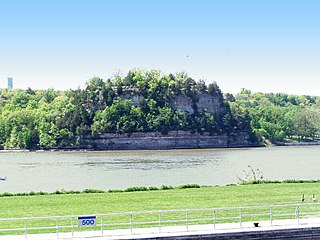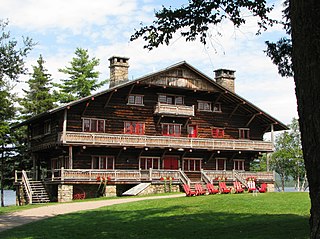
Huntington is a city in Cabell and Wayne counties in the U.S. state of West Virginia. The county seat of Cabell County, the city is located at the confluence of the Ohio and Guyandotte rivers. Huntington is the second-most populous city in West Virginia, with a population of 46,842 as of the 2020 census. Its metro area, the Huntington–Ashland metropolitan area, is the largest in West Virginia, spanning seven counties across three states and having a population of 376,155 at the 2020 census.

Scouting in Indiana has a long history, from the 1910s to the present day, serving thousands of youth in programs that suit the environment in which they live.

The Fort Wayne Old City Hall Building in downtown Fort Wayne, Indiana operates as a museum known as The History Center, and has served as headquarters for the Allen County–Fort Wayne Historical Society since 1980. The Richardsonian Romanesque style sandstone building was designed by the architectural firm Wing & Mahurin and built in 1893. It served as a functioning city hall for the city until 1971 when local officials moved to the City-County Building.

Starved Rock State Park is a state park in the U.S. state of Illinois, characterized by the many canyons within its 2,630 acres (1,064 ha). Located just southeast of the village of Utica, in Deer Park Township, LaSalle County, Illinois, along the south bank of the Illinois River, the park hosts over two million visitors annually, the most for any Illinois state park.

Great Camp Sagamore is one of several historic Great Camps located in the Adirondack Mountains of northern New York State.

Fort Recovery was a United States Army fort ordered built by General "Mad" Anthony Wayne during what is now termed the Northwest Indian War. Constructed from late 1793 and completed in March 1794, the fort was built along the Wabash River, within two miles of what became the Ohio state border with Indiana. A detachment of Wayne's Legion of the United States held off an attack from combined Indian forces on June 30, 1794. The fort was used as a reference in drawing treaty lines for the 1795 Treaty of Greenville, and for later settlement. The fort was abandoned in 1796.

Stony Point Battlefield is a historic site in Rockland County, New York; the location of the 1779 Battle of Stony Point during the American Revolutionary War. It is a National Historic Landmark and has a museum.

The LeConte Memorial Lodge, now known as the Yosemite Conservation Heritage Center, is a structure in Yosemite National Park in California, United States. LeConte is spelled variously as Le Conte or as Leconte. Built in 1903 by the Sierra Club, it is nearly unique within the National Park Service system as a high-quality example of Tudor Revival architecture, and is an important early expression of the Club's mission. The lodge was declared a National Historic Landmark in 1987.
Huntington is home to dozens of parks located in the neighborhoods of Huntington. An amusement park is also adjacent to the city.

Camp Pine Knot, also known as Huntington Memorial Camp, on Raquette Lake in the Adirondack Mountains of New York State, was built by William West Durant. Begun in 1877, it was the first of the "Adirondack Great Camps" and epitomizes the "Great Camp" architectural style. Elements of that style include log and native stonework construction, decorative rustic items of branches and twigs, and layout as a compound of separated structures. It is located on the southwest tip of Long Point, a two-mile long point extending into Raquette Lake, in the Town of Long Lake in Hamilton County, New York.

The Grand Canyon Lodge is a hotel and cabins complex at Bright Angel Point on the North Rim of the Grand Canyon. It was designed by Gilbert Stanley Underwood, who designed a number of other hotels in national parks for the Utah Parks Company and other concessioners. Built in 1927–28, the Grand Canyon Lodge resort complex consists of the Main Lodge building, 23 deluxe cabins, and 91 standard cabins, some of which were moved to the north rim campground in 1940. All guests are housed in cabins detached from the main lodge, which serves as a dining, concessions and service facility. Constructed of native Kaibab limestone and timber, the complex was designed to harmonize with its rocky and forested setting. The Grand Canyon Lodge complex is notable for its setting and rustic design, as well as its status as the only complete surviving lodge and cabin complex in the national parks.

Benjamin A. Muncil was an American master builder in the Adirondacks early in the 20th century. He was a major figure in the architectural development of the Adirondack Great Camps; among his many projects was Marjorie Merriweather Post's Camp Topridge, Northbrook Lodge, and White Pine Camp, a summer White House of US President Calvin Coolidge.

Wayne Township is one of twelve townships in Huntington County, Indiana, United States. As of the 2020 census, its population was 470.

Waynesborough, also known as the Gen. Anthony Wayne House, is a historic house museum at 2049 Waynesborough Road in Easttown Township, Chester County, Pennsylvania. Built in 1724 and repeatedly enlarged, it was for many years the home of American Revolutionary War general Anthony Wayne (1745–1796). A National Historic Landmark, it is now a museum operated by the Philadelphia Society for the Preservation of Landmarks, offering tours and event rentals.

West Vernor–Junction Historic District is a commercial historic district located along West Vernor Highway between Lansing and Cavalry in Detroit, Michigan. The district includes 160 acres (0.65 km2) and 44 buildings. The district was listed on the National Register of Historic Places in 2002.

The Grand Lake Lodge hotel was opened in 1920 to serve tourists visiting Rocky Mountain National Park via the Trail Ridge Road, completed the same year. Located in Grand Lake, Colorado, the rustic lodge was founded by Frank Huntington and Roe Emery on land owned by the National Park Service at the edge of the park. The resort was affiliated with the Chicago, Burlington & Quincy Railroad.
Buckberg mountain is a hill above the Hudson River that played a role in American Revolutionary War strategy concerning the Hudson Highlands.

The Chickasaw Council is a local council of the Boy Scouts of America that serves Scouts in Shelby County, Tennessee, as well as Crittenden county in eastern Arkansas and fifteen counties in northwest Mississippi. It was founded on February 22, 1916, to oversee the many Boy Scout troops already present in Memphis, Tennessee. The Chickasaw Council has two camps: Kia Kima Scout Reservation and Camp Currier. The Chickasaw Council is also home to the Order of the Arrow Ahoalan-Nachpikin Lodge 558. The council is divided into 8 districts; as well as the Exploring programs.

This is a list of the National Register of Historic Places listings in Allen County, Indiana.

Underhill State Park is a state park in Underhill, Vermont. It is situated on the west slope of 4,300 feet Mount Mansfield, in the 39,837-acre Mount Mansfield State Forest. Activities includes hiking, camping, mountain biking, stream fishing, wildlife watching, and picnicking. Facilities include group and individual camping areas, a picnic shelter, and hiking trails. The park is formally open between Memorial Day weekend and Columbus Day weekend, but is accessible for periods outside those times; fees are charged. Much of the park's infrastructure was built by the Civilian Conservation Corps (CCC) in the 1930s; these facilities were listed on the National Register of Historic Places in 2002.



















